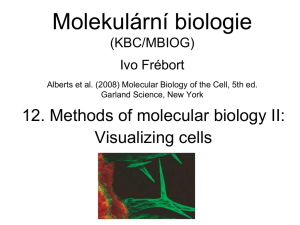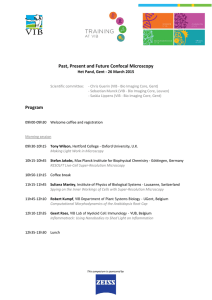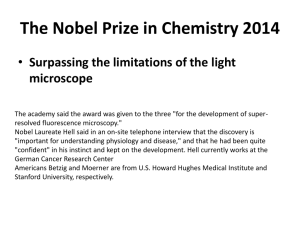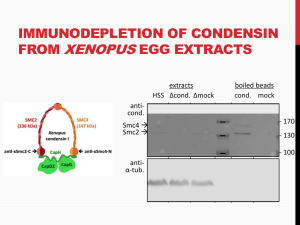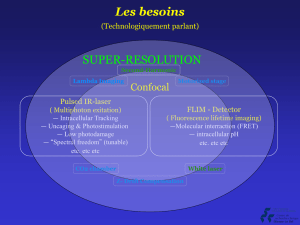Bio 177
advertisement
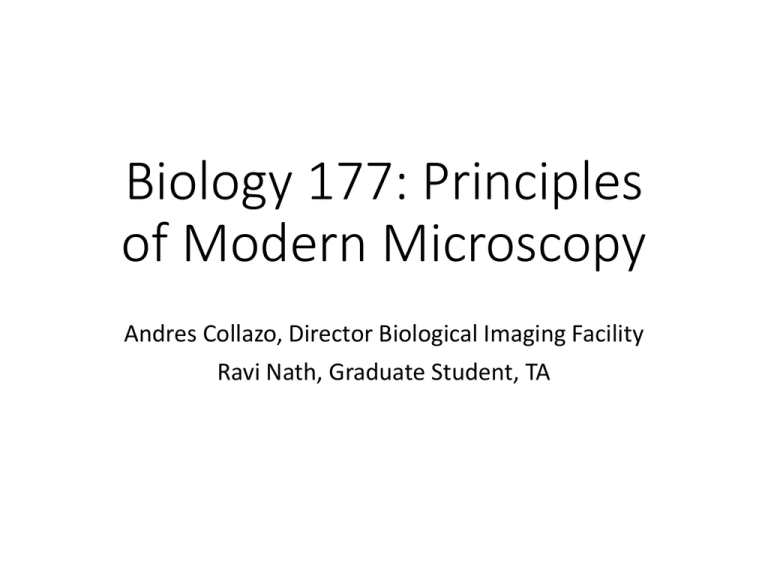
Biology 177: Principles of Modern Microscopy Andres Collazo, Director Biological Imaging Facility Ravi Nath, Graduate Student, TA Biology 177: Where and When? • Broad 200 • Tuesday & Thursday • 10:30 am -12:00 pm • Will this start time work for people? Sister Course Biology 227: Methods in Modern Microscopy • Will be taught next year (Winter 2016) • Laboratory class • Located in Church, room 68 • Attendance limited Biology 177: Principles of Modern Microscopy • What it will be: • • • • Basic optics and microscopy Laser scanning microscopy Contrast Mechanisms Image rendering and processing • What it can’t be: • A review of all microscopy techniques • Optics design, etc Biology 177: Principles of Modern Microscopy • Fundamentals of light microscopy • wide-field • confocal microscopy • Contrast and sample preparation • phase and DIC optics • fluorescent labels • Advanced techniques • • • • • • quantitative imaging two photon microscopy super resolution microscopy 3-D imaging and rendering light sheet microscopy fluorescence correlation spectroscopy Biology 177: Principles of Modern Microscopy • Course Work: • • • • Reading Simple problem sets Projects No exams • Projects (two): • • • • Read and summarize a publication Describe technology How could it have been done better? Must say one good thing about paper. • Note: Auditors welcome Biology 177: Principles of Modern Microscopy • 177 TA: Ravi Nath (rnath@caltech.edu) • Course website: http://www.its.caltech.edu/~bi177/ • Dropbox account for lectures, etc. Why does light pass through glass? • Lecture by Tim Hunt. • Summer Courses at the Woods Hole Marine Biological Laboratory www.mbl.edu How does a photon of light interact with solids? • Absorption • Reflection • Mirror • Transmission • Glass is an amorphous solid • Photons pass through without interacting with electrons • This brings us to a branch of physics called optics Optics – understanding the behavior and properties of light. • Based on the bending of light as it passes from one material to another • Duality of light • • Particle nature Wave nature Why use visible light for microscopy? (l) Planck–Einstein relation E=hn n = c/l (n) E = hc/l Geometrical optics • Approximation important technically and historically • Analogous to Newtonian mechanics for macroscopic objects • Light as collection of rays • Simplest example: • Light striking a mirror • Angle of incidence = angle of reflection qi qr Mirror Refraction of Light • Passing from one medium to another • Deviation angle (qr) gets larger the more light tilted from vertical • One of few places in Greek physics with experimental results qi Interface qr Refraction of Light • Passing from one medium to another • Deviation angle (qr) gets larger the more light tilted from vertical • One of few places in Greek physics with experimental results qi Interface qr Developing a Physical Law Snell’s law: sin 𝜃𝑖 = η sin 𝜃𝑟 η = 1.33 for water Claudius Ptolemy 150 AD Willebrord Snell 1621 Angle in air Angle in water Angle in air Angle in water 10° 8° 10° 7-1/2° 20° 15-1/2° 20° 15° 30° 22-1/2° 30° 22° 40° 29° 40° 29° 50° 35° 50° 35° 60° 40-1/2° 60° 40-1/2° 70° 45-1/2° 70° 45° 80° 50° 80° 48° Important to acknowledge nonWestern influences • Alhazen, medieval Arab Scholar • Wrote 7 volume Book of Optics (1011-1021) • Translated to Latin in 12th or 13th Century • Standard text on optics for next 400 years • Had a formulation of Snell’s law 2015 United Nations International Year of Light. (http://www.light2015.org) Why does light take the long path? Fermat’s principle of least time • Light takes path that requires shortest time • Explains why you can see the sun after its sets below horizon qi Interface qr Feynman Lectures on Physics, Volume I, Chapter 26 http://feynmanlectures.caltech.edu/I_26.html Why does light take the long path? Fermat’s principle of least time • Light takes path that requires shortest time • Explains why you can see the sun after its sets below horizon • Also explains angle of reflection A qi qr Mirror A’ Feynman Lectures on Physics, Volume I, Chapter 26 http://feynmanlectures.caltech.edu/I_26.html History of the microscope begins in the Netherlands Middelburg Amsterdam Delft Late 1500’s to 1600’s How do these first microscopes differ from a magnifying glass? • Simple microscopes • One lens http://micro.magnet.fsu.edu/primer/museum/index.html Simple versus compound microscopes • Simple has single lens (or group of lenses) creating one magnified image • Compound has 2 sets of lenses, one creates magnified image inside microscope, 2nd set magnifies to create 2nd image • Zacharias Janssen may have invented first microscope, which was compound (~1595) http://www.history-of-the-microscope.org Differences Between Microscopes and Telescopes Microscope Telescope Differences Between Microscopes and Telescopes Microscope Telescope • Small objects • Close up • Here and now • Large objects • Far away • Time machine The basic light microscope types Upright microscope . Inverted microscope Illumination via Transmitted Light Upright microscope Inverted microscope . The specimen must be transparent ! Illumination via “Reflected” (Incident) Light Upright microscope Inverted microscope . Eg. Fluorescence, Opaque Samples Mixed Illumination Upright microscope . Inverted microscope Illumination Techniques - Overview Transmitted Light Incident Light • Brightfield • Oblique • Brightfield • Oblique • • • • • • • • Darkfield Phase Contrast Polarized Light DIC (Differential Interference Contrast) • Fluorescence - not any more > Epi ! Darkfield Not any more (DIC !) Polarized Light DIC (Differential Interference Contrast) • Fluorescence (Epi) Fluorescence microscopy • First fluorescence microscope built by Henry Seidentopf & August Köhler (1908) • Used transmitted light path • So dangerous that couldn’t look through it, needed camera Image credit: corporate.zeiss.com “Technical Milestones of Microscopy” The “F” words FRET FFS FLIM FCS FRAP FLAM FACS FIGS FCCS The “F” words FRET FFS FLIM FCS FRAP FLAM FACS FIGS FCCS The “F” words FRET FFS FLIM FCS FRAP FLAM FACS FIGS FCCS Improve fluorescence with optical sectioning • Wide-field microscopy • Illuminating whole field of view • Confocal microscopy • Spot scanning • Near-field microscopy • For super-resolution www.olympusfluoview.com Typical compound microscope is not 3D, even though binocular Stereo (dissecting) microscopes compound, binocular and 3D • “Couldn’t one build a microscope for both eyes, and thereby generate spatial images?” • Question addressed to Ernst Abbe in 1896 by Horatio S. Greenough Ernst Abbe (1840-1905) 1897 – the first Stereo Microscope in the world, built by Zeiss Drawing by Horatio S. Greenough - 1896 Greenough Type Introduced first by Zeiss - 1897 Common Main Objective Type Introduced first by Zeiss - 1946 Stereo microscopes are to microscopes As binoculars are to telescopes Distinguishing between normal and stereo microscopes not always easy Discovery Axio Zoom Distinguishing between normal and stereo microscopes not always easy Discovery Axio Zoom What was the first image sensor? What was the first image processor? What was the first image sensor? What was the first image processor? The eye What was the first image sensor? What was the first image processor? The eye What was the first image sensor? What was the first image processor? The eye The brain Detectors: From analog to digital • Film • CMOS (Complementary metal–oxide–semiconductor) • CCD (Charge coupled device) • PMT (Photomultiplier tube) • GaAsP (Gallium arsenide phosphide) • APD (Avalanche photodiode) Image processing • 3D Reconstruction A Neural Gata-2 Promoter GFP-Transgenic Zebrafish; Shuo Lin, UCLA • Deconvolution P Top: Macrophage - tubulin, actin & nucleus. Bottom: Imaginal disc – α-tubulin, γ-tubulin. How do we document observations using microscopes? • Francesco Stelluti first to publish in 1625 • Cofounder of Accademia dei Lincei • Hand drawings • Giovanni Faber another member of Accademia dei Lincei coined the word microscope (~1625) First camera that could take permanent photographs invented in 1826 • Joseph Niépce French inventor • Perfected with Louis Daguerre • Camera obscura, 5th century B.C, Mozi • Camera lucida, 1807, William Hyde Wollaston 1904 Microscopy exhibit of Arthur E. Smith that shocked Edwardian London. • Royal Society's Annual Conversazione 1904 Microscopy exhibit of Arthur E. Smith that shocked Edwardian London. History of microscopy 1595: The first compound microscope built by Zacharias Janssen 1600 1700 Video microscopy developed early 1980s (MBL) 1994: GFP used to tag proteins in living cells 1910: Leitz builds first “photomicroscope” 1800 1955: Nomarski invents Differential Interference Contrast (DIC) microscopy 1900 2000 1680: Antoni van Leeuwenhoek awarded fellowship in the Royal Society for his advances in microscopy 2010 Super-Resolution light Microscopy 1960: Zeiss introduces the “Universal” model Images taken from: Molecular Expression and Tsien Lab (UCSD) web pages 1934: Frits Zernike invents phase contrast microscopy Slide from Paul Maddox, UNC Resolution • More than just magnification • Can understand through geometrical optics, • But best understood by looking at wave not particle nature of light • Future lecture Resolution vs Contrast • More than just magnification • Can understand through geometrical optics, • But best understood by looking at wave not particle nature of light • Future lecture • Note simultaneous contrast illusion Super-resolution microscopy • Most recent Nobel prize • Many ways to achieve • True • Functional • 2 lectures on this • These techniques tend to be slow In America we like things fast. • Fast food • Fast cars In America we like things fast. • Fast food • Fast cars • Fast microscopes • Temporal resolution • Many ways to achieve • 2 Lectures on this Image Credit: Michael Weber Can you see the problem of high speed microscopy? Can you see the problem of high speed microscopy? SETS Where do we want to go in the future? • High speed • Super-resolution • Single molecule imaging • Fluorescence correlation spectroscopy (FCS) • Total internal reflectance microscopy (TIRF) (Photo by Jonathan Stephens http://www.jrsfilm.com/) Where do we want to go in the future? • High speed • Super-resolution • Single molecule imaging • Fluorescence correlation spectroscopy (FCS) • Total internal reflectance microscopy (TIRF) qi Interface qr Where do we want to go in the future? • High speed • Super-resolution • Single molecule imaging • Fluorescence correlation spectroscopy (FCS) • Total internal reflectance microscopy (TIRF) qi Interface qr Where do we want to go in the future? • High speed • Super-resolution • Single molecule imaging • Fluorescence correlation spectroscopy (FCS) • Total internal reflectance microscopy (TIRF) qi qi Interface Visualize Single Proteins in Living, Intact Organisms Microscopy Resources on the Web • http://www.olympusmicro.com • Olympus • http://www.microscopyu.com • Nikon • http://zeiss-campus.magnet.fsu.edu • Zeiss Acknowledgements • Scott E. Fraser, USC • Rudi Rottenfusser, Carl Zeiss • Paul Maddox, UNC http://biblescripture.net/Greek.html
